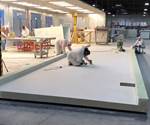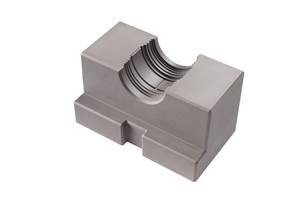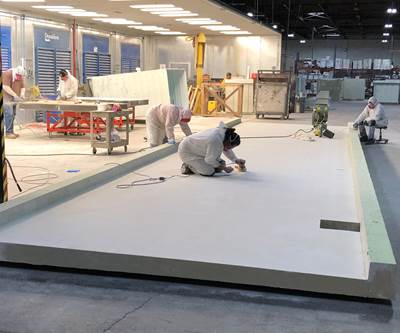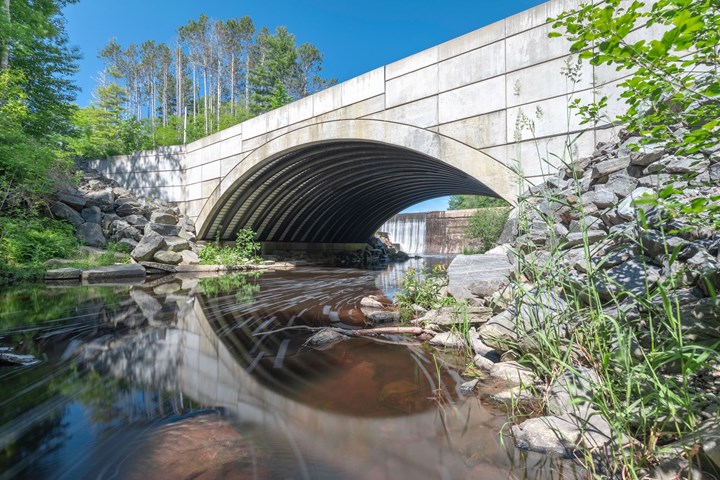
Arch bridge system. AIT Bridges’ arch bridge system uses braided fiber-reinforced polymer (FRP) tube filled with concrete. It can be applied to various bridge structures and can span up to 80 feet. Source | AIT Bridges
Aging infrastructure is an often-cited global problem with bridges, waterfronts and other structures in need of rehabilitation, and in many cases, replacement. Composites offer the advantages of corrosion resistance and durability, which contribute to low maintenance and long service life for structures, contributing to life cycle cost savings and a long-term economic advantage over traditional materials such as steel and concrete. Many advocates in the composites industry, from material suppliers to fabricators, are working to spread awareness about the benefits advanced materials offer to update infrastructure the world over. Resistance to change, concerns over unit material costs and skepticism over the performance of new materials have proven difficult hurdles for advanced materials advocates to overcome, but all of that is gradually starting to change.

Lightweight for safety. Composite manhole covers weigh approximately one third of manhole covers made with traditional materials, reducing the potential for injury due to manual handling. Source | Fibrelite
Fibrelite (Skipton, U.K.), a brand of OPW (Hamilton, Ohio, U.S.), a Dover (Downers Grove, Ill., U.S.) company, specializing in composite access and manhole covers, has recognized a shift to composites over the last decade or so, as metal and concrete covers are gradually being replaced using composite materials. Jo Stott, marketing director for Fibrelite, cites a combination of corrosion resistance, light weight and higher load ratings as the reason behind the shift.
Fibrelite’s composite covers weigh approximately one third of traditional materials, which helps decrease manual handling injuries while retaining mechanical properties. In many cases the covers can be manufactured to fit existing frames, cutting installation time and costs. “The market is maturing and customers are becoming more comfortable with making the switch,” Stott says. “And that drives change in the rest of the market.”
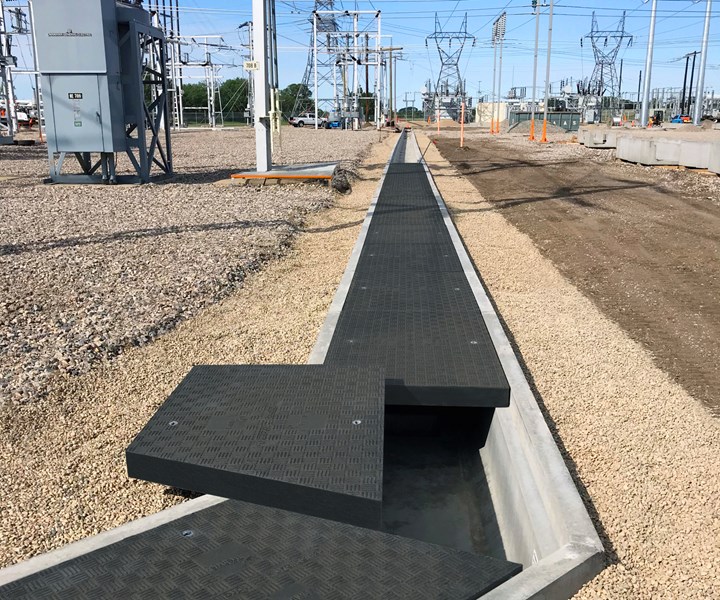
In the trenches. Composite access covers offer numerous advantages including lighter weight, corrosion resistance and anti-skid patterns to provide a safe walking surface. Source | Fibrelite
As awareness of the advantages of composites expands, many fabricators and suppliers say conversations with civil engineers are turning away from resistance to change and skepticism over material capabilities to other factors such as cost and capabilities of the materials. And that’s a good thing. The goal is not to replace legacy materials but to allow engineers and designers to fully understand the potential of composites so they can make informed decisions.
“We know we’re not going to displace steel; steel has a very definite place in the market. Pre-cast concrete, which is reinforced with steel, also has its place in the market,” says Brit Svoboda, CEO and chairman of AIT Bridges (Brewer, Maine, U.S.), an engineering and manufacturing company specializing in composite materials for bridges. “But there is definitely a reason to add alternative technologies using advanced material to increase longevity, to provide lightweight transportation and mobility of [infrastructure] products and, if nothing more, to drive the market to better performance specifications,” he adds.
According to Scott Reeve, president and CEO of Composite Advantage (Dayton, Ohio, U.S.), which fabricates very large composite structures for infrastructure markets, the points of discussion have shifted from the capabilities of composite materials to cost and maintenance. “When I’m presenting to designers, engineers, contractors, there are very few questions about the structural capabilities or structural integrity anymore,” he says. Instead Reeve finds himself talking about the same questions that pre-cast concrete and other traditional materials face such as how long the material will last, how well the joints hold up over time, and what kind of maintenance will need to be performed.
In the U.S., new legislative efforts such as the IMAGINE Act (Innovative Materials for America’s Growth and Infrastructure Newly Expanded), which was introduced in August of 2018, are helping to increase awareness of the potential lifecycle cost savings that composite materials can provide for infrastructure projects.
“The nation’s leaders have noted America needs more than a trillion dollars’ worth of investment to rehabilitate bridges, water systems, dams and the electric grid,” says Tom Dobbins, president of the American Composites Manufacturers Assn. (ACMA, Arlington, Va., U.S.). “Composites are uniquely poised to provide real-world solutions to meet this demand.”
“Legislation that encourages state agencies to use [composites] and demonstrate their benefits is definitely applauded,” says Gregg Blaszak, a licensed engineer and co-founder of Coastline Composites (Lancaster, Pa., U.S.), a consulting firm that works with manufacturers of FRP composite products. “Once those benefits are understood, the materials will and must be able to stand on their own.”
Coastline Composites has been helping FRP composite product manufacturers develop infrastructure applications for more than 15 years. The company got its start working in the marine and waterfront market to introduce FRP sheet piling and FRP bridge protection systems. Blaszak has noticed the beginnings of a sea change for composites use in infrastructure.
“As years have gone on, we’ve started to see more engineers really start taking a hard look at these types of materials because they are, for the most part, maintenance free,” Blaszak says. One example, he says, is the increasing number of projects specifying fiberglass rebar for reinforcing concrete structures as an alternative to traditional steel rebar.
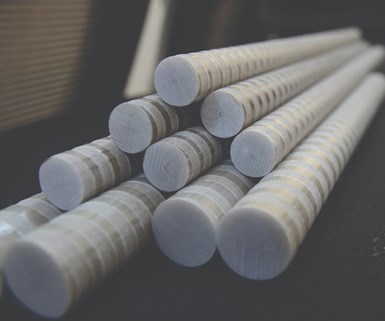
FRP rebar. Composite rebar offers an alternative to steel reinforcements with advantages including corrosion-resistance, improved durability, lightweighting, improved ease-of-installation, greater tensile strength and longer service life than traditional rebar. Source | Owens Corning
“Fiberglass reinforcement bars have been around for 30 years, but are now starting to be utilized more frequently to reinforce concrete structures as a substitute or an alternative to traditional steel,” he says.
Corrosion of steel rebar is a leading cause of the deterioration of concrete structures. The service life of concrete reinforced with steel rebar is limited to around 25 years, rather than the 75-100 years once estimated. Composite rebar, such as that produced by Owens Corning (Toledo, Ohio, U.S.), offers an alternative to steel reinforcements with advantages that include corrosion resistance, improved durability, lightweighting, ease of installation, greater tensile strength and longer service life. Owens Corning’s Fiberglas rebar is made up of fiberglass roving in a vinyl ester resin matrix and is well suited for structures exposed to deicing salts, seawater or other corrosive agents. The rebar is available in 20- and 40-foot lengths in #2, 3, 4, 5, 6, 8 and 10 diameter bars, as well as custom diameters. Later in 2020, the company is launching a new composite rebar it calls Pinkbar that is designed to be lighter and stronger than steel rebar.
“I expect to see the continued development of fiberglass rebar in structural applications and increasingly in flatwork applications,” says Christopher Skinner, vice president, strategic marketing, composites for Owens Corning. “Contractors are seeing increased strength and weight reduction versus steel which significantly increases productivity for their crews. I expect that the durability of composite materials will soon be factored into purchase decisions.”
Looking beyond rebar, Blaszak believes FRP is gaining momentum in infrastructure projects because in some cases the costs of rehabilitation outweigh initial cost savings realized through the use of traditional materials.
“We’ve started to see more and more agencies, like the Navy and some of the more progressive DOTs [departments of transportation] consider the future costs of rehabilitation or replacement because of their first-hand experiences fixing deteriorated structures which can be very costly and are usually accompanied by severe disruptions to communities and the public [e.g. bridge closures],” Blaszak says. “The initial material and construction costs, while important, are not always the singular deciding factor in selecting materials.”

Quick installation. Composite Advantage’s fiber-reinforced polymer (FRP) FiberSPAN system was chosen for a quick, lightweight, corrosion-resistant solution to repair to an 87-year-old bascule bridge in Michigan City, Ind., U.S. that buckled due to low temperatures. Source | Composite Advantage
Bridges pave the way
According to a 2019 report from the American Road and Transportation Builders Assn. (Washington, D.C., U.S.), more than 47,000 bridges in the U.S. are in poor condition and in need of immediate rehabilitation. Of the approximately 614,400 bridges in the U.S., approximately 245,000 have exceeded their estimated service life of 50 years. Couple that with the fact that legacy bridges will continue to reach states of disrepair with continued aging, and a picture of a country at the edge of an infrastructure precipice comes into focus.
New bridge projects continue to provide examples of how composites and advanced materials can help rebuild crumbling infrastructure and create new lightweight, corrosion-resistant, sustainable structures that can stand the test of time and the elements. In addition, composites allow for bridge customization, versatility and speed to market that can’t always be achieved with traditional materials. Companies like Composite Advantage and AIT Bridges are working to rehabilitate existing bridges and build new ones that can exceed the lifespan of current structures.
For example, in February 2019, record-breaking low temperatures buckled the Franklin Street Bridge in Michigan City, Ind., U.S., an 87-year-old bascule bridge that uses counterweights to raise and lower its spans to provide clearance for boat traffic. Composite Advantage’s fiber-reinforced polymer (FRP) FiberSPAN system was chosen for a quick, lightweight, corrosion-resistant solution to repair the bridge’s crumbling concrete leaves and steel supports.
“The traditional approach called for a temporary steel plate until the weather warmed up enough to accommodate the 28-day cure requirement for concrete,” Reeve says. “But that would have taken months. It also meant paying for two repairs and closing the bridge to traffic twice. The need for light weight eliminated most material options.”
To fix the problem, Composite Advantage prefabricated the panels with mechanical clips for bolting the deck to the steel stringers. The FRP supplier was able to design, prefabricate, ship and install the panels in just 32 days, allowing the bridge to reopen in April 2019 (more on the company’s Franklin Street bridge project).
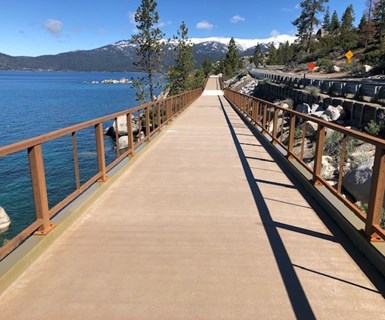
Shared-use path. Composite Advantage’s FRP FiberSPAN system was used to build a new new shared-use path along Nevada’s State Route 28 along Lake Tahoe. The light weight of the FRP solution allowed workers to meet the demands of construction on the region’s uneven slopes. Source | Composite Advantage
In addition to repairs, Composite Advantage works on new bridge projects as well. In June 2019, the Nevada Department of Transportation (NDOT) and the Tahoe Transportation District opened a new shared-use path manufactured using the company’s FRP FiberSPAN system along Nevada’s State Route 28 — a two-lane, mountainside road bordering 11 miles of Lake Tahoe’s undeveloped shoreline. Thirty-two 40-foot bridge span sections were installed, creating five distinct bridges, used in areas where the slope was too steep to provide flat walking surfaces. The goal of the shared-use path is to support an anticipated increase in traffic, protect the area’s ecosystem and deal with problems of limited parking and safe access points. The light weight of the FRP solution allowed workers to meet the demands of construction on the region’s uneven slopes (more about Composite Advantage’s Tahoe East shore trail project).
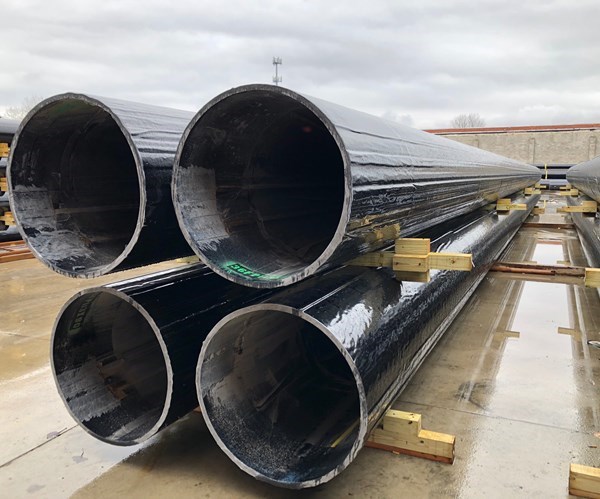
FRP Pilings. Composite Advantage’s pilings offer a high strength-to-weight ratio and can reduce the number of pilings needed in a marine structure. CW Photo | Scott Francis
In addition to the bridge decks, Composite Advantage’s offerings include composite pilings and fender systems, which have been used to rehabilitate aging waterfront infrastructure including a bridge at a seaside resort at the southern tip of New Jersey’s Cape May Peninsula.
“We’re able to fabricate our pilings with a high strength-to-weight ratio, which means we can make a very structurally efficient pile,” Reeve says. In the Cape May Peninsula project, the company’s FiberPILE FRP system was able to cut the number of piles needed for the structure in half, thereby offering cost savings. Composite Advantage met the necessary 250 kip-foot energy absorption impact load using 53 composite piles, ultimately replacing 141 original wooden piles (Read about Composite Advantage’s Cape May Project).
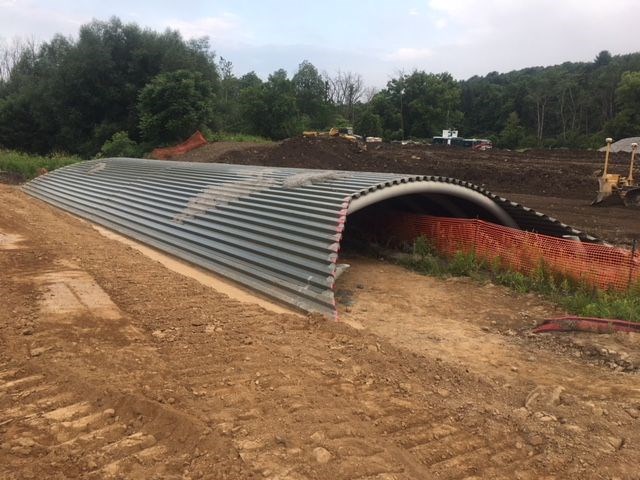
Pultruded decking. AIT Bridges’ composite arch system is covered with pultruded FRP decking panels that use a polyurethane matrix. Source | AIT Bridges
AIT Bridges’ composite arch system was developed at the University of Maine’s Advanced Structure and Composite Center (Orono, Maine, U.S.) and has been used to build more than 25 medium span overfill bridges since its introduction in 2008. The system is based on a braided fiber-reinforced polymer (FRP) tube filled with concrete and used as a support structure for bridge structures that span up to 80 feet. The FRP provides the stay-in-place form for the concrete as well as external reinforcing and protection from the elements by providing a weather-resistant, non-corrosive outer layer. On top of the arches are the main support members, which are then covered with pultruded FRP decking panels that use a polyurethane resin. The company’s lightweight Atlas decking panels can be manufactured to any length, attach to the composite arches with self-tapping screws, and support backfill.
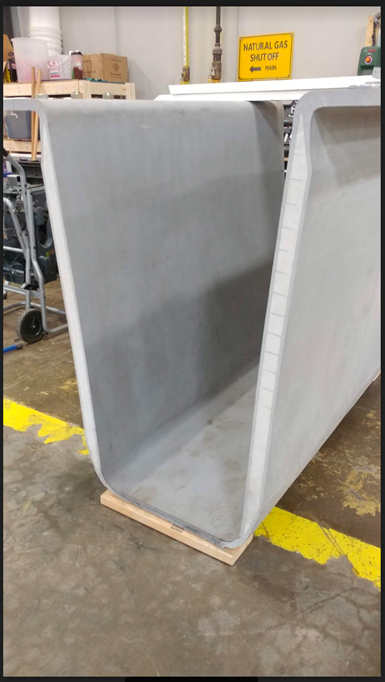
Composite tub girder. In addition to use for bridges, AIT Bridges’ CT girder system can be used for parking garages, floor and roof decks and other architectural applications. Source | AIT Bridges
Developed over the last three years in conjunction with the University of Maine’s Advanced Structure and Composite Center, AIT Bridges’ latest innovation is its composite tub (CT) girder system consisting of a U-shaped FRP girder supported on standard foundations and covered with precast or cast-in-place concrete bridge decking. The depth and width of the girder can be customized to meet project site requirements; maximum length is 120 feet.
“One of the advantages of working with composites is you’re not tied in tightly to very specific standardized designs and architectures,” says Ken Sweeney, president and chief engineer of AIT Bridges. “With steel and concrete you’re kind of stuck with what strength and mechanical properties that they have. With composites you can architecturally design what you need to meet the requirements for the particular project, which is one of the big values that you get out of using composites.”
In addition to use for bridges and highway overpasses, the girder can also be used for parking garages, floor and roof decks and other architectural applications. AIT Bridges’ first CT girder bridge will be built in Hampden, Maine in 2020 (read more about AIT Bridges’ CT girder bridge system).
The company has also developed a Mobile Composite Manufacturing Unit (MCMU) that can be located at a bridge site and used to fabricate parts on location. The 20-foot self-contained manufacturing unit is fully outfitted with all the tools and equipment necessary for manufacture, allowing for local and scalable manufacturing at a low capital cost. The units can be outfitted and shipped globally.
Raising the bar on infrastructure
One of the exciting things about all of the work to get advanced materials more readily accepted for infrastructure projects is that it is raising awareness about the need for higher standards for all materials — both advanced and traditional. With the conversation moving from the initial cost of advanced materials to the overall value of those materials, taking into account cost savings realized from time and labor saved during construction due to lightweighting, as well as the long-term cost savings due to lower maintenance and increased longevity of the structures, much fairer and objective consideration when choosing materials for infrastructure projects is happening with increased frequency. Plus, new innovations are constantly improving cycle times and efficiencies for processing of composite materials, making them increasingly competitive right out of the gate.
“We’re hoping that we not only will begin to set standards that everybody else will have to grow up and into by building things that last longer, we hope to be able to do it and demonstrate that we can also do it on a first cost-competitive basis,” Svoboda says. “That will really put the pressure on everybody to step up their game and provide a long-term solution to taxpayers, and provide longer-lasting, better products.”
Related Content
Industrializing additive manufacturing in the defense/aerospace sector
GA-ASI demonstrates a path forward for the use of additive technologies for composite tooling, flight-qualified parts.
Read MoreMetal AM advances in composite tooling, Part 2
Toolmakers and molders continue to realize the benefits of additive versus conventional/subtractive manufacturing of molds and mold components.
Read MoreA new era for ceramic matrix composites
CMC is expanding, with new fiber production in Europe, faster processes and higher temperature materials enabling applications for industry, hypersonics and New Space.
Read MoreSMC composites progress BinC solar electric vehicles
In an interview with one of Aptera’s co-founders, CW sheds light on the inspiration behind the crowd-funded solar electric vehicle, its body in carbon (BinC) and how composite materials are playing a role in its design.
Read MoreRead Next
Plant Tour: Composite Advantage
Composite Advantage supplies engineered fiber reinforced polymer (FRP) products including bridge decks, trail bridges, cantilever sidewalks, rail platforms, as well as waterfront structures such as fender protection systems, pilings and naval ship separators.
Read MoreDeveloping bonded composite repair for ships, offshore units
Bureau Veritas and industry partners issue guidelines and pave the way for certification via StrengthBond Offshore project.
Read MorePlant tour: Daher Shap’in TechCenter and composites production plant, Saint-Aignan-de-Grandlieu, France
Co-located R&D and production advance OOA thermosets, thermoplastics, welding, recycling and digital technologies for faster processing and certification of lighter, more sustainable composites.
Read More


